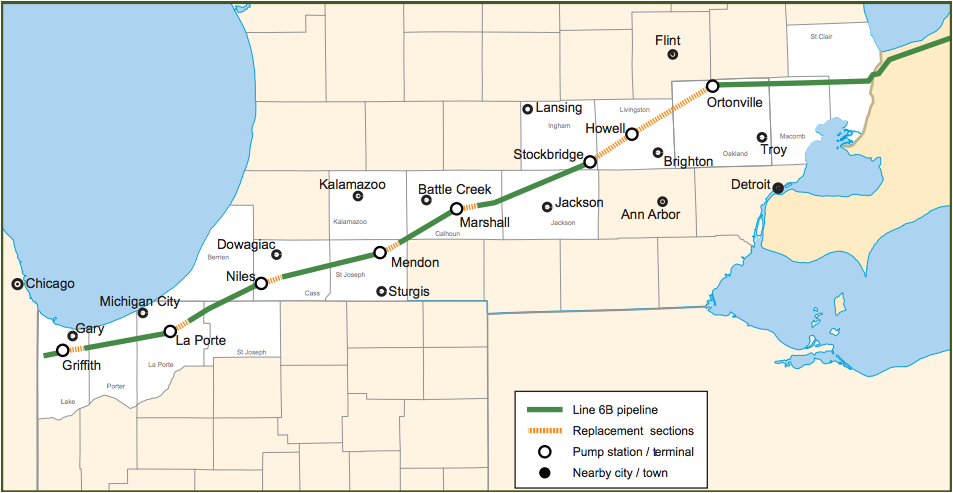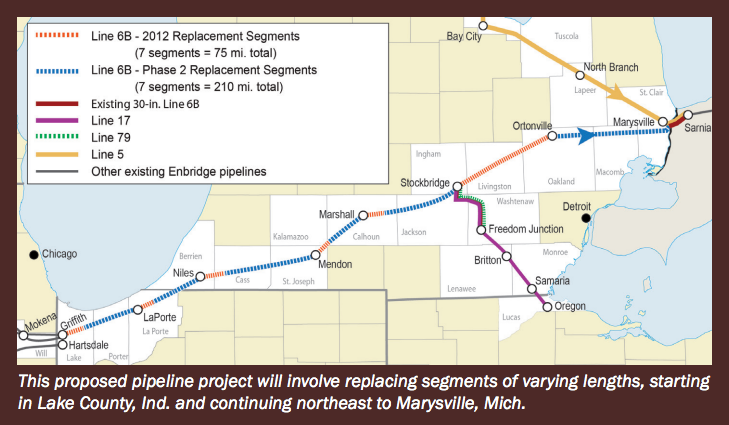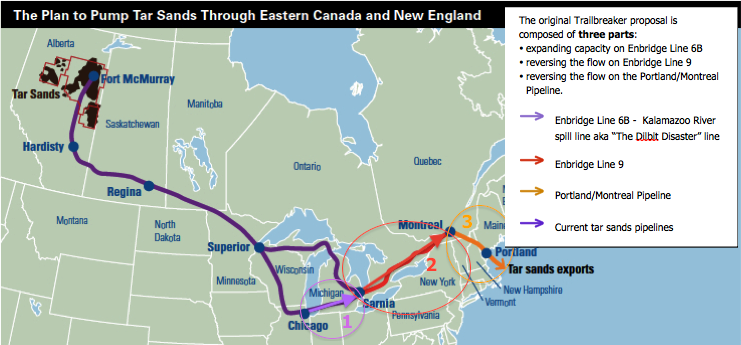With the two year anniversary of the “Dilbit Disaster” fresh on our minds it seems improbable that Enbridge, the company responsible for the 1 million gallon spill of dilbit, or diluted bitumen, on a tributary of the Kalamazoo River in Michigan, is currently pushing through a plan to expand that same pipeline.
The proposed expansion of Enbridge’s Line 6B which extends from Griffith, Indiana to Sarnia, Ontario will more than double the pipeline’s existing capacity, to 500,000 barrels per day (bpd) from 240,000 bpd.
The first phase of the expansion, already underway, will see 75 miles of pipeline segments replaced.

In April, Enbridge applied to replace an additional 210 miles of pipeline: 160 miles of increased-capacity pipes in Michigan and an additional 50 miles of pipeline in Indiana.
This second phase, which is currently under review, will replace the remaining portions of Line 6B, essentially installing a new pipline from Griffith, Indiana to the St. Clair River in Marysville.

Dubbing the expansion a “maintenance and rehabilitation project,” Enbridge advertises “added property tax revenues” for Indiana and Michigan, promising “an influx of sales tax,” a “welcome boost in employment,” and “fewer disruptions to landowners and local communities over the long term.”
However, Enbridge’s $2.2 billion expansion of Line 6B is more likely part of an ongoing project to carry Alberta heavy tar sands bitumen to the east coast.
The piecemeal rebuilding of Line 6B, as well as recently approved line reversals of connecting pipelines, have environmental organizations concerned Enbridge is quietly reviving plans to construct the Trailbreaker pipeline, while avoiding the regulatory overviews and public engagement associated with the larger-scale project.
The Trailbreaker pipeline, initially proposed in 2008, was intended to carry tar sands oil all the way to the coast as Enbridge executives outlined in this 2008 investor’s call. The project was shelved in 2009 due to the flagging economy.
The initial project involved three separate pipelines: Enbridge Line 6B, Enbridge Line 9 and the third-party Portland-Montreal Pipeline, managed by Montreal Pipe Line Ltd. and the Portland Pipeline Corporation (but owned in majority by Imperial Oil Ltd. and Suncor, the tar sands largest producer). The original Trailbreaker plan required an expansion of Line 6B and the flow reversal of both Line 9 and the Portland-Montreal line.

Image Source: 350.org Vermont
In July the Canadian National Energy Board (NEB) announced their approval of the Line 9 reversal, despite concerns from opposing parties. In the official decision letter, the NEB noted Line 9’s relevance to the Trailbreaker project as voiced by prominent environmental groups whose concerns drew the application into a public hearing process.
The letter states:
“On 26 August 2011, a letter was submitted that was signed by Environmental Defence, Équiterre, Pembina Institute and Vermont Natural Resources Council (EED). In this letter, EED assumed that Phase I was in fact part of Enbridge’s Trailbreaker project, announced in July 2008, to move heavy oil through Montreal and onward for export to Portland, Maine, and points beyond. In the letter, EED asserted that by narrowly scoping the Trailbreaker project into pieces, the Board would not be able to discharge its regulatory duties and the public would have difficulty engaging in a transparent and meaningful process.”
Despite such concerns the NEB approved Enbridge’s request to reverse the flow of Line 9 and downplayed the significance of the application to the preexisting Trailbreaker project.
This, despite the fact that, before the approval was granted operators of the Portland-Montreal Line indicated their interests in reversing the line’s flow and put in an application to build a pumping station along the Quebec boarder. The request – eventually denied to the operators in a Quebec court ruling – would have been crucial for the line’s reversal.
Environmental groups in Quebec, Vermont and Maine are celebrating the court’s decision as a temporary hindrance to the tar sands’ run for the eastern seaboard.
But they anticipate that this little-publicized, French-language ruling isn’t the last we will see of the Trailbreaker.
Subscribe to our newsletter
Stay up to date with DeSmog news and alerts






